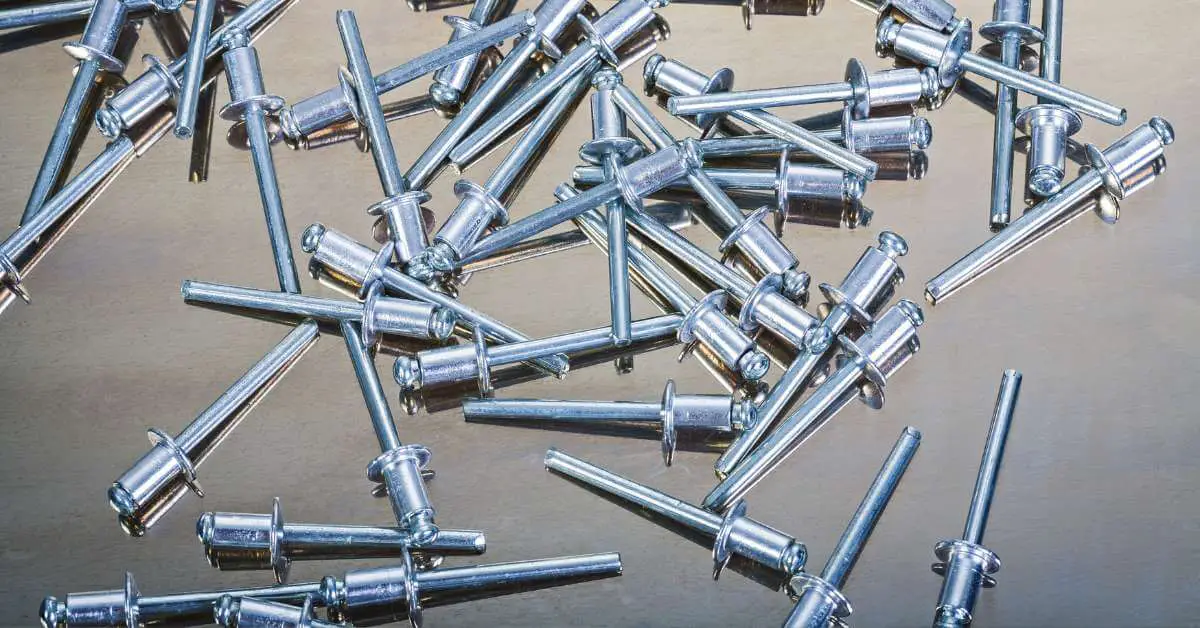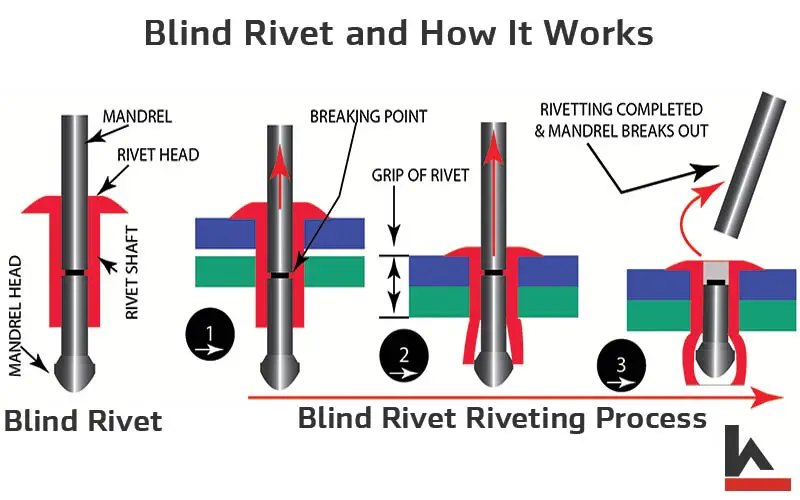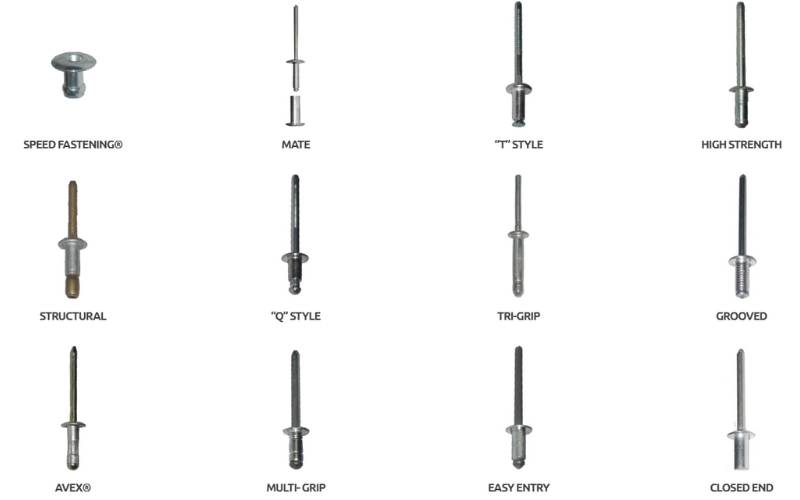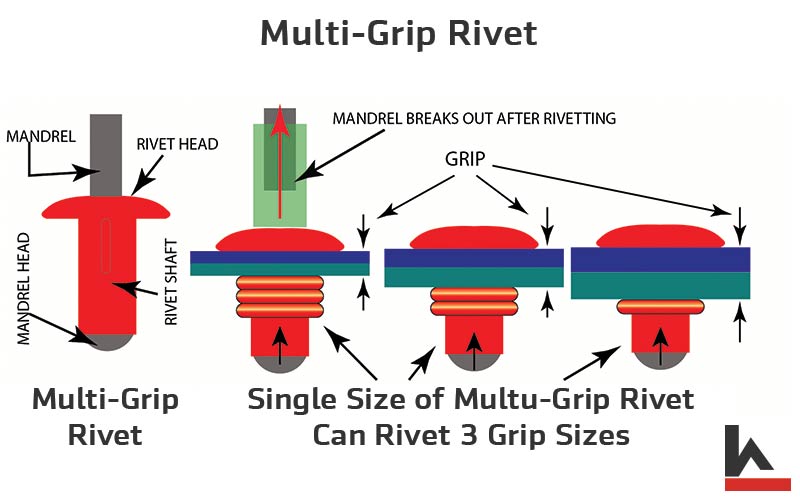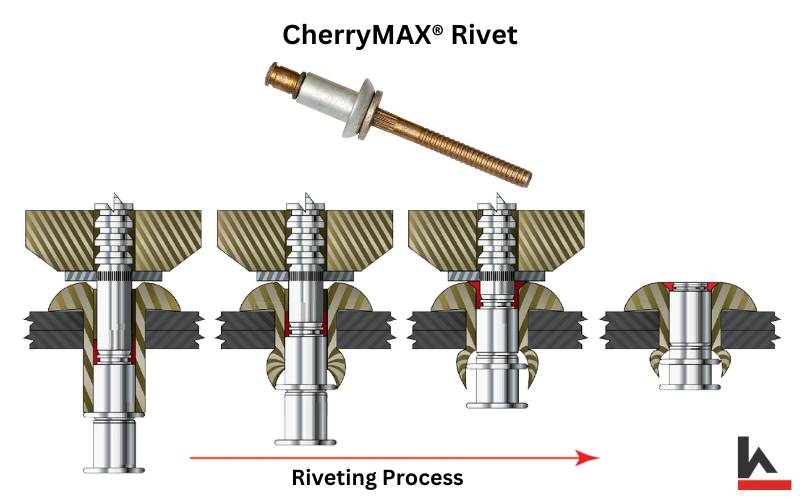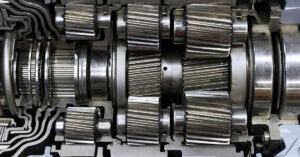Imagine a situation where you need to fasten two sections together in an assembly. The conventional approach would involve the use of a bolt and nut. However, what happens when the other side of the assembly isn’t accessible for the placement of a nut, as in the case of joining a metal piece to a pipe or a blind wall? The solution lies in using a particularly handy fastener, the blind rivets.
As the name suggests, ‘blind rivets’ do not necessitate rear or ‘blind end’ access to carry out the joint. This unique characteristic sets them apart and makes them an ideal choice in such scenarios. Let’s discuss the functionality and applications of these creative fasteners.
What is a Blind Rivet?
Blind rivets, also known as pop rivets, are popular in many industrial sectors due to their specific design for situations where the other side of a workpiece is inaccessible. These one-sided fasteners are extensively utilized in various industries, including shipbuilding, electronics, automotive, and aerospace.
The standard operation of blind rivets involves inserting them into pre-drilled holes in the workpiece. However, a variant known as ‘self-drilling rivets’ eliminates even this requirement, adding a layer of convenience to their use.
These fasteners offer superior performance in a wide array of applications. As an added bonus, they are also more economical than traditional fastening alternatives like screws, bolts and nuts, or welding. This makes them an attractive choice for manufacturers.
All reputable blind rivet manufacturers adhere to specifications established by the Industrial Fasteners Institute based in the USA. Known as ‘Break Mandrel Rivets’ in these specifications, the design and performance standards of blind rivets are rigorously maintained to ensure quality and reliability.
Pop Rivets: Installation and Removal Steps
Installing a Blind Rivet
Installing a blind rivet involves four primary steps that ensure a strong and secure joint:
- Rivet Placement: Position the shell (shaft) of the blind rivet into the pre-drilled hole in your workpiece.
- Mandrel Pull: Using a rivet tool, apply force to pull the mandrel or stem upward. As this occurs, the mandrel head, located at the opposite end, simultaneously pulls the shell, creating a new rivet head at the other end and forming a secure joint.
- Stem Break: Once the force applied to the stem meets its designed level, the stem breaks off. The broken part is then discarded.
- Head Retention: The head portion of the stem remains in the shell (at the blind end), providing a strong fastening strength.
The upward force application on the mandrel or stem can be performed using specially designed hand tools or pneumatic or electric-powered tools, depending on your specific needs.
Removing Blind Rivets
There may be instances where you’d like to remove a blind rivet. Follow these steps, ensuring you take care not to damage the workpiece or the rivet hole:
- Stem Examination: Check if the stem sits below the rivet head. If not, use a punch to drive it beneath the head.
- Drilling the Rivet: Using a drill bit of the recommended size for the rivet hole, drill through the rivet head until enough material is removed from the shell. For ease, you can periodically retract the drill to clear the chips. Once done, the rivet head may come out with the drill.
- Final Punch and Clean-Up: Utilize a punch to drive out any remaining shell material. Finalize the process by removing any burrs from the rivet hole.
Now, your rivet hole is all set to receive a new rivet!
Riveting Tools for Blind Rivets
Different types of riveting tools cater to varying needs and usage levels:
- Pneumatic Riveting Tools: Ideal for production lines with high work volume and speed requirements.
- Hand-Operated Riveting Tools: Suitable for workshops with lower work volume and DIY enthusiasts.
- Electrically Operated Riveting Tools: Less popular due to their slower operation, making them less ideal for large-scale projects.
Understanding the different types of blind rivets and riveting tools allows you to choose the most suitable option for your specific application.
The Pros and Cons of Blind Rivets
Blind rivets have earned popularity across various industries due to their distinct advantages, yet they come with certain limitations. Here’s an in-depth look at the pros and cons of using blind rivets.
Advantages of Blind Rivets
- Cost-Efficiency: Installing blind rivets requires minimal skilled labor, boasting a high productivity rate. A semi-skilled worker can secure approximately 12 to 15 blind rivets per minute, making the per-rivet labor cost significantly lower than other fasteners.
- Versatility: Blind rivets are available in various sizes, materials, and types, catering to an array of application needs. Their adaptability makes them a go-to option for even the most challenging fastening requirements.
- Reliability: With the correct size and type of blind rivet, one can achieve a strong and reliable fastening. These rivets hold well against vibrations and various conditions surrounding the joint, thus ensuring stability.
- Single-Sided Installation: Blind rivets allow for ‘blind’ installation, which means they can be installed from one side of the workpiece. This is highly beneficial when the other side is inaccessible.
- Consistent Clamping Force: Unlike other fastening devices, blind rivets provide consistent clamping force, guaranteeing a secure hold. This reduces the chances of the joint loosening over time or under vibrations.
- Less Equipment Required: Generally, the installation of blind rivets only requires the proper rivet gun, making the process simpler and more cost-effective than those requiring additional equipment.
Disadvantages of Blind Rivets
While blind rivets host an array of benefits, they do have a noteworthy limitation:
- Limited Fastening Strength: Their fastening capability may fall short compared to the fastening strength of some other fasteners. Therefore, they’re best suited for assembling thin-gauge material parts.
- Improper Installation Risks: If not installed correctly, blind rivets may not hold securely. This could result in a weak joint or rivet failure.
Types of Pop Rivets (Blind Rivets)
Blind rivets have evolved, creating various types designed to meet specific applications and requirements. Here’s a comprehensive list of some popular specialized blind rivets:
Multi-Grip Rivets
Multi-grip rivets offer a secure joint across a broader grip range than standard blind rivets. The sides of the shell initially collapse, and once a tight fit is achieved, the shell deforms to create the necessary clamping force. Common applications include:
- Stormwater pipes
- Air-conditioning ducts
- Similar applications requiring adjustable clamping force
Large Flanged Head Blind Rivets
These rivets have an oversized head which is exceptional for fastening soft and brittle metals, delivering additional fastening force to the joint.
Grooved Rivets
Featuring angular grooves on the shell diameter, grooved rivets exhibit excellent holding power when used with materials such as plastics and wood.
Aluminum Sealed Blind Rivets
Aluminum-sealed blind rivets ensure a waterproof joint, making them ideal for:
- Water tanks
- Roofing
- Residential aluminum windows
Aluminum Peel Rivets
Aluminum peel rivets are versatile and well-suited for blind riveting soft materials without causing damage. The shell’s vertical slits peel outward when the mandrel is pulled, with the mandrel head pushing the peeled parts to fasten the materials together. The mandrel is then cut once the pulling force reaches its designed level.
What is a CherryMAX Rivet?
CherryMAX Rivets, often recognized as ‘Cherry Rivets,’ are a popular form of blind rivets boasting unparalleled strength and reliability. Cherry Aircraft Company initially developed them for the aerospace industry, and they quickly became a standard for their durability and easy installation process.
Key features of CherryMAX Rivets include:
- Tri-folding design: Unlike typical blind rivets that expand radially, CherryMAX Rivets employ a unique “bulbing” mechanism. This tri-folding design offers a large blind side footprint and even load distribution – making them resistant to high shear and pull forces.
- Built-in Stem Mechanical Lock: CherryMAX rivets feature a mechanically-locked stem that provides a secure and vibration-resistant joint. The stem breaks flush to the rivet head, eliminating sharp edges or protrusions.
- Widely Applicable: Originally designed for the aerospace sector, their exceptional performance and easy-to-install nature have led to their use in other industries, including automotive, defense, and infrastructure.
The combination of these key attributes makes CherryMAX Rivets a preferred choice, upholding the highest performance and security standards in riveting applications.
Understanding the Construction of Blind Rivets
Blind rivets are typically composed of two main elements: the shell and the stem, sometimes referred to as a mandrel, which includes a head. These two parts are uniquely assembled to enable the shell’s insertion into the parts that need to be combined or fastened together.
Material of the Shell and Stem
Blind rivets have gained popularity due to the range of combinations of materials they offer. The ideal shell material needs to consider the strength requirements, corrosion resistance, and workpiece material. Here are some common material choices:
- Aluminum: Offers lightness, sufficient strength, and good corrosion resistance.
- Zinc-coated Steel: Provides greater strength than aluminum and has a certain level of corrosion resistance.
- Stainless Steel: Boasts good strength and excellent resistance against corrosion.
- Nickel: Provides exceptional strength, excellent conductivity, and corrosion-resistant properties.
- Copper: is soft compared to other metals but has good corrosion resistance and conductivity.
- Monel (nickel-copper alloy): combines the properties of nickel and copper.
Stem materials are typically less critical as the major part of the stem is discarded after the riveting process. However, it’s worth noting that the stem should have equivalent or greater strength than the shell material to deform the shell at the blind end effectively.
Steel is the most common stem material used; aluminum and stainless steel are also employed in some rivet designs. When steel is used as a stem material, the part retained in the shell at the blind end may rust, which may not be desirable in some cases. For such instances, a blind rivet with an aluminum or stainless steel stem can be used.
Head Shapes
The blind rivet head can take on these common shapes:
- Normal Truss Head: Used extensively, this type of head protrudes above the surface of the top workpiece, sharing the load of fastening and adding aesthetic value to the rivet joint.
- Countersunk Head: Requires a countersunk on the top workpiece and sits flush after riveting.
- Large Truss Head: Similar to the normal truss head but bigger, providing additional fastening force, useful for fastening brittle or soft workpieces.
Blind Rivet Grip Range and Breaking Load
The breaking load, essential for snapping the stem, is calculated based on the deformation necessary for the shell to fasten the workpieces securely. Accordingly, a groove is cut into the mandrel to a specific depth, slightly away from the head. The breaking load should ideally be optimum – too less load results in insufficient fastening, while an overly high load risks damaging the workpiece.
Just like a set of bolts and nuts apply a clamping force to a joint, a blind rivet applies the same purpose, providing a secure fastening. To ensure this happens correctly, the mandrel shouldn’t break under a force below the designed clamping force of the blind rivet. If the mandrel breaks at a force less than the designed force, the rivet joint’s integrity could be at risk.
Grip Range
The grip range, or grip thickness, refers to the total thickness of the workpieces that need to be fastened by the rivet. Each blind rivet is specifically designed according to the grip range it has to fasten. The degree of shell deformation during the riveting process is also determined by this grip range.
If the length of the blind rivet is more and the grip thickness (range) is less, the riveting process might leave excess material on the blind side, resulting in imperfect fastening. This scenario can cause the mandrel to break prematurely, before the riveting process is completed at the blind end.
Conversely, if the blind rivet is shorter for a larger grip range, the shell material at the blind end might not be enough to create a proper rivet head, leading to imperfect fastening again.
Preventing Galvanic Corrosion in Riveted Joints
Galvanic corrosion, sometimes referred to as dissimilar metal corrosion, is a phenomenon that occurs when two different metals come into contact in the presence of an electrolyte – think moisture in the air or marine atmospheres. This chemical-electrical process can spur accelerated deterioration of one metal over the other.
In the case of blind rivets, when the shell’s material differs from the workpieces, and both are exposed to atmospheric moisture or marine atmosphere, galvanic corrosion can occur. The rate of this corrosion depends on the conductivity of the electrolyte and the relative contact area between the dissimilar materials.
Blind rivets are commonly used to fasten dissimilar materials such as aluminum, copper, zinc-coated steel, brass, stainless steel, and more. Under dry conditions, these dissimilar metals won’t face significant degradation. Yet, for applications like air conditioners or joints exposed to atmospheric or marine conditions, additional care is required to lessen the impacts of galvanic corrosion.
Some guides outline which dissimilar materials are compatible with riveting and which should be avoided. But here are some extra preventative measures to mitigate galvanic corrosion:
- Take great care when selecting the shell material of the blind rivet.
- Use barriers like rubber gaskets, plastic washers, or paint to separate dissimilar materials.
- Choose materials with similar corrosion properties.
- Design a drainage system to quickly remove the electrolyte (like moisture) from rivet joints.
- Utilize rivets with an anodized coating to offer an extra layer of protection.
Wrapping Up
Understanding the intricate details of blind rivets – from their essential elements, the suitable material combinations, the functionality of diverse head shapes, and grip range considerations to managing breaking loads – can significantly improve the quality of your construction and manufacturing endeavors.
Moreover, valuable knowledge on potential challenges, such as galvanic corrosion and the importance of selecting correct rivet materials, is crucial in maintaining the longevity and integrity of the joint connection in varying environmental conditions.
Remember, despite the simplicity of rivets, their role is vitally important in many applications. Therefore, investing time in learning and planning can save you from costly mistakes and unnecessary repairs in the future.
We hope this guide provides helpful insights into the world of blind rivets, equipping you with the necessary knowledge to make informed choices in your projects. Remember, the small details make a big difference!
Related Article: What Is Riveting & How Does Riveting Work? | Types of Rivets
Reference:

